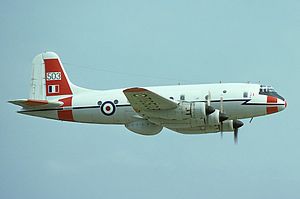| Hastings | |
|---|---|
 Hastings TG503 in flight in June 1977 | |
| General information | |
| Type | Transport aircraft |
| Manufacturer | Handley Page |
| Primary users | Royal Air Force (RAF) Royal New Zealand Air Force (RNZAF) |
| Number built | 151 |
| History | |
| Manufactured | 1947–1952 |
| Introduction date | September 1948 |
| First flight | 7 May 1946 |
| Retired | 1977 (RAF) |
| Variants | Handley Page Hermes |
The Handley Page HP.67 Hastings is a retired British troop-carrier and freight transport aircraft designed and manufactured by aviation company Handley Page for the Royal Air Force (RAF). Upon its introduction to service during September 1948, the Hastings was the largest transport plane ever designed for the service.
Development of the Hastings had been initiated during the Second World War in response to Air Staff Specification C.3/44, which sought a new large four-engined transport aircraft for the RAF. Early on, development of a civil-oriented derivative had been prioritised by the company, but this direction was reversed following an accident. On 7 May 1946, the first prototype conducted its maiden flight; testing revealed some unfavourable flight characteristics, which were successfully addressed via tail modifications. The type was rushed into service so that it could participate in the Berlin Airlift; reportedly, the fleet of 32 Hastings to be deployed during the RAF operation delivered a combined total of 55,000 tons (49,900 tonnes) of supplies to the city.
As the RAF's Hastings fleet expanded during the late 1940s and early 1950s, it supplemented and eventually replaced the wartime Avro York, a transport derivative of the famed Avro Lancaster bomber. RAF Transport Command operated the Hastings as the RAF's standard long-range transport; as a logistics platform, it contributed heavily during conflicts such as the Suez Crisis and the Indonesian Confrontation. A handful were also procured by the Royal New Zealand Air Force (RNZAF) to meet its transport needs. Beyond its use as a transport, several Hastings were modified to perform weather forecasting, training, and VIP duties. A civilian version of the Hastings, the Handley Page Hermes, was also produced, which only achieved limited sales. Hastings continued to be heavily used by RAF up until the late 1960s, the fleet being withdrawn in its entirety during 1977. The type was succeeded by various turboprop-powered designs, including the Bristol Britannia and the American-built Lockheed Hercules.